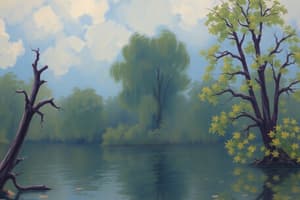Podcast
Questions and Answers
What element of poetry refers to a group of lines forming a basic metric unit?
What element of poetry refers to a group of lines forming a basic metric unit?
- Meter
- Tone
- Rhyme
- Stanza (correct)
All types of stanzas have the same number of lines.
All types of stanzas have the same number of lines.
False (B)
What is the oldest surviving poem mentioned in the content?
What is the oldest surviving poem mentioned in the content?
Epic of Gilgamesh
In poetry, a _____ scheme is the pattern of sounds that repeats at the end of a line or stanza.
In poetry, a _____ scheme is the pattern of sounds that repeats at the end of a line or stanza.
Match the following types of meter with their definitions:
Match the following types of meter with their definitions:
Which type of rhyme scheme involves lines that all rhyme with each other?
Which type of rhyme scheme involves lines that all rhyme with each other?
Rhythm in poetry is associated solely with the use of rhyme.
Rhythm in poetry is associated solely with the use of rhyme.
Name one figure of speech mentioned in the content that goes beyond literal meanings.
Name one figure of speech mentioned in the content that goes beyond literal meanings.
Flashcards
Poetry
Poetry
Literature using language to create a specific emotional response or imaginative awareness through sound, rhythm, and meaning.
Epic of Gilgamesh
Epic of Gilgamesh
The oldest surviving poem with an unknown origin, featuring the king of Uruk, Gilgamesh.
Stanza
Stanza
A group of lines in a poem forming a basic unit of structure, rhyme pattern, mood, and thought.
Rhyme Scheme
Rhyme Scheme
Signup and view all the flashcards
Rhythm in Poetry
Rhythm in Poetry
Signup and view all the flashcards
Meter
Meter
Signup and view all the flashcards
Tone & Mood
Tone & Mood
Signup and view all the flashcards
Figurative Language
Figurative Language
Signup and view all the flashcards
Study Notes
Poetry
- Poetry evokes imaginative awareness of experience, using language for meaning, sound, and rhythm.
- Examples of poetry include the Epic of Gilgamesh, the oldest surviving poem of unknown origin.
Elements of Poetry
Stanza
- A stanza is a group of lines forming a basic unit in a poem.
- Its purpose includes creating structure, pattern (like rhyme), organizing thoughts, setting a mood, and using shape for symbolism.
- Types of stanzas include couplets (2 lines), tercets (3), quatrains (4), cinquains (5), sestets (6), septets (7), and octaves (8).
Rhyme
- Rhyme scheme is the pattern of sounds that repeat at the end of lines or stanzas.
- Rhyme schemes can change throughout a poem.
- Alternate rhyme repeats end sounds between lines; monorhyme repeats the same end sound across multiple lines, and coupled rhyme repeats the same end sound per couplet.
Rhythm and Meter
-
Rhythm is the beat and pace of a poem, associated with stressed and unstressed syllables.
-
Meter is the pattern of stressed and unstressed syllables (units).
-
Types of meter:
- Lamb: unstressed-stressed
- Trochee: stressed-unstressed
- Dactyl: stressed-unstressed-unstressed
- Anapest: unstressed-unstressed-stressed
- Spondee: stressed-stressed
- Pyrrhic: unstressed-unstressed
Tone and Mood
- Tone is the writer's attitude toward the subject, speaker (persona), or audience.
- Mood is the feeling created by the vocabulary, rhyme, and figurative language in a poem.
Figurative Language
- Figurative language uses words not literally, creating more impactful and persuasive communication.
- Figures of speech like simile, metaphor, and allusion add new meaning, while alliteration, imagery, and onomatopoeia engage the senses.
Studying That Suits You
Use AI to generate personalized quizzes and flashcards to suit your learning preferences.




